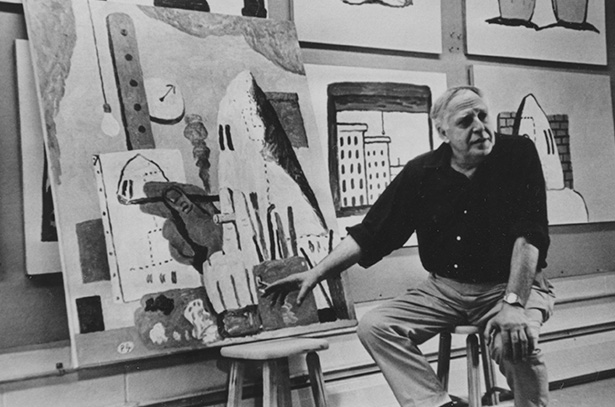
Philip Guston
What Endures
30 July 2020
Online Exhibition
Beginning 30 July, Hauser & Wirth will present ‘Philip Guston. What Endures,’ an online exhibition that responds directly to our present moment of overwhelming uncertainty by reflecting upon pain, endurance, and, ultimately, hope for the future, through the work of Philip Guston. Featuring works selected by Musa Mayer, the artist’s daughter and President of The Guston Foundation, the exhibition includes thirteen important paintings made between 1971 and 1976, a time of social and political turmoil in the United States with many parallels to the current state of crisis in America and the world at large.
It was during this period of immense cultural unrest and critical rejection of his new work that Guston, guided solely by his own intuition and determination, pushed forward and committed to creative reinvention, refusing to be defined by adversity. The paintings that came out of this challenging time, including those on view in this presentation, are considered some of the most important works of the 20th century. They bear witness to an artist at the height of his powers, acutely responsive to his world.
Comprised of three virtual viewing rooms that together create a powerful narrative arc, ‘What Endures’ is a meditation upon the past, present, and the dream of a better future. The exhibition ultimately testifies t o t he transformative power of art and its ability to uncover the universal truth: love.
In the first section, titled The Solace of the Past, works on view find Guston exploring relics, ruins, and the timelessness of art as sources of inspiration in the present day. His smaller paintings of Roman ruins and gardens from 1971, and the larger ‘Relic’ (1974), are steeped in nostalgia and a longing for continuity. As Musa Mayer writes, ‘In these fragments, what endures from an earlier time is revealed.’
The exhibition continues with The Rising Tide, featuring a series of paintings from 1974 to 1975 that share a common sense of foreboding and encroachment as the sadness of the world threatens to engulf the artist’s solitary life in his studio. In ‘Afloat’ (1974), the younger heads of Guston and his wife Musa are half-drowned in a rising red sea. In ‘Head-Legs-Sea’ (1975), Musa’s head, still sunken, floats beside upturned legs and shoes. In ‘Lower Level’ (1975), a solitary figure stands witness as a group of legs are sunk in a pit or a mass grave. A red rain suggests blood. The discarded legs of these two works are clear precursors to the potent leg paintings of 1976 that recall the Holocaust.
In ‘Four Heads’ (1975), the artist emerges from a state of dread into another symbolic realm, where the marriage of creative minds becomes his subject. The red tide now resembles bedclothes. A painting hangs in the foreground, and the rightmost Musa-head suggests a book, perhaps a reference to her poetry.
The third and final section of the exhibition, Deliverance, is comprised of a single remarkable painting completed by Guson in 1976. In the transcendent ‘Both’ (1976), the transformation is complete. Two heads of Musa rise from the horizon. The youthful Musa has yellow hair and upturned eyes, while the gray-haired Musa is half sunk into the blue sea, her brow furrowed. The storm appears to have ended, and the sea and sky are a peaceful blue. In a note found in his desk, dated September 28, 1972, Guston wrote: ‘There is nothing to do now, but paint my life: my dreams, surroundings, predicament, desperation, Musa—love, need. Keep destroying any attempt to paint pictures, or think about art.’
As Mayer has written, ‘In these strange, evocative, yet intensely personal images, the artist uncovers what is universal. In uncertain times, in the midst of overwhelming circumstance, it is love that endures.’
‘Philip Guston. What Endures’ is complemented by previously unseen filmed interviews with the artist and archival imagery from his studio.
Catalogue Raisonné and Forthcoming Exhibitions
The exhibition follows the 26 June 2020 launch of The Guston Foundation website, philipguston.org, which includes a catalogue raisonné archiving all works through the artist’s five-decade career. This extensively illustrated resource —intended for scholars and the general public alike — provides an in-depth look at the life and work of Philip Guston. The creation of the website and catalogue raisonné has been a seven-year project of The Guston Foundation, which was founded in 2013 by Musa Mayer.
In 2021, the first major retrospective e xhibition in a generation o n Guston’s a rt and legacy, ‘Philip Guston Now,’ will debut at Tate Modern, London in February 2021 with subsequent presentations at the National Gallery of Art in Washington, DC, the Museum of Fine Arts, Boston, and the Museum of Fine Arts, Houston. An accompanying catalogue, also titled ‘Philip Guston Now’, includes curatorial essay by the National Gallery of Art’s Harry Cooper with texts by ten contemporary artists on Guston’s ongoing influence. The catalogue is published by the National Gallery of Art and distributed by D.A.P.
About the Artist

Philip Guston
Philip Guston (1913 – 1980) is one of the great luminaries of twentieth-century art. His commitment to producing work from genuine emotion and lived experience ensures its enduring impact. Guston’s legendary career spanned a half century, from 1930 to 1980. His paintings—particularly the liberated and instinctual forms of his late work—continue to exert a powerful influence on younger generations of contemporary painters. For an in-depth overview of his career, click here.
Current Exhibitions
1 / 12














